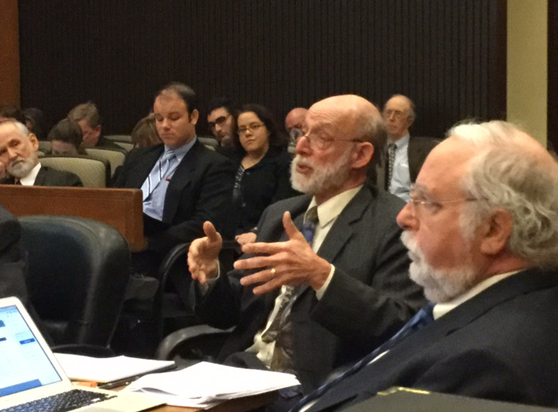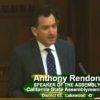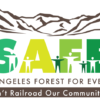February 11th the long awaited hearing for Tos/Fukuda/Kings County case, Part 2 was heard in front of the same Superior Court Judge Michael Kenny.
Part one covered legal aspects of the funding plan and was decided in favor of the plaintiffs only to be partially overturned by a Sacramento Appellate court because the Legislature accepted a defective funding plan and the Authority wasn’t asking to spend construction dollars via a second funding plan yet. In the end, it was deemed too early in the process.
The lawsuit was effective though, since as of today, the Rail Authority has been unable to access state bond funds for construction since they have not been able to achieve Prop1A hurdles once described by an Appellate court as an intentional “financial straight-jacket.”
This time plaintiffs are attempting to prove that:
- The train cannot perform at the required 2 hours and forty minutes from Los Angeles Union Station to the San Francisco Transbay Terminal nor can they achieve thirty minutes between San Francisco and San Jose.
- The blended program is inconsistent with the Program level Environmental documents required in Prop 1A.
- The project is financially unviable. It’s clear to see now even prior to the filing of the 2nd funding plan.
If project opponents (plaintiffs) are successful in proving any of these allegations, they will ask that the judge order the Authority to stop the spending of funds until the Authority can comply. The Authority warns that the judge cannot do that because of separation of powers. It cannot interfere with legislative action since they have the right to appropriate funds for the project.
The judge will weigh the evidence in the administrative record in a snapshot approach that is, what was in evidence before the Rail Authority as April 2014, the date the 2014 Business Plan was published. The judge will then compare where the Rail Authority is in their planning compared with the mandates of Prop 1A. Without this approach the Rail Authority could argue until project completion that it was too early to judge the project because they haven’t either made their final decision yet or could change their decision in the future.
One of the most important determinations by the court will be who has the right to alter a bond measure. California has strong case law about protecting bond measures voted on by the public. The Authority representation, Deputy Attorney General Sharon O’Grady stated in their reply brief that Legislature has the constitutional authority to amend the bond act as long as it does not make substantial changes. Plaintiffs argue that the kind of changes that the Authority and the Legislature are attempting to make is substantial in nature and should be approved by the public.
Financial Viability with a little history:
Proponents (the Authority and Attorney General) argue Prop 1A financial protections applies only to the use of the bond funds even though it was understood from the beginning that to develop the project would require other funding sources such as Federal grant funds or private investment funds.
The $9.95 billion dollars in bond debt was envisioned merely as seed money to get the project going. It was never envisioned that the Authority would use federal funds only or bond funds separately. It was always envisioned these shared funds would build the rail system using the system approved by the public in the bond measure.
In reality, it is a fact that the Rail Authority has already admitted they don’t have enough funds to build the first initial operating segment they chose…that’s 300 miles of a high-speed rail system. The rail authority even admits in financial and audit committee documents that they might have to shorten the path of even the first 130 miles because they can’t get their hands on the $2.7 billion in state bond funds because of lawsuits.
The Authority still contends to this day that the cost will remain around the $68 billion mark, most recently cited by Authority Board Chairman Dan Richard at a state Assembly oversight hearing on January 27, 2016. They are basing this on project estimates coming in from contractors lower than expected but they have no substantial record of actual construction. When the actual bills start rolling in there is a good chance the cost will go higher than the estimate with cost overruns and change orders. See Republican Assembly member Jim Patterson from Fresno questioning the rail authority members at that Assembly meeting about the cost and the routing. https://www.youtube.com/watch?v=r5FW138rodA&feature=youtu.be
The Attorney General (AG) claims even if the court agrees with the plaintiffs and finds something the Authority has done deficient; the court may not stop the expenditure of federal funds or state cap-and-trade revenue. They claim the court would intrude on the Legislative appropriation authority. In addition, the AG claims in their reply brief that the plaintiffs arguments that there are minimum requirements for “any HSR system, is entirely unsupported and without merit.” They believe the bond act “governs the use of bond funds, nothing more.”
Stuart Flashman, the Oakland environmental attorney representing the plaintiffs, raised the lack of substantial evidence behind the Authority’s ridership studies and in fact behind all expert documents and studies. He gave as an example; the only ridership analysis of the Initial Operating Segment South is what was extrapolated from the full phase 1 Los Angeles Union Station to San Francisco Transbay Terminal analysis. Prop 1A requires an analysis for each operating segment built that shows there is sufficient ridership to turn a profit. AG noted the ridership has been reviewed by a Ridership Review Panel and the federal General Accounting Office. Mr. Flashman contends that neither the Peer Review Panel nor the GAO ever reviewed ridership for the Initial Operating segment.
Travel Time:
Experts have analyzed the route with the shortest mileage possible, giving the Authority the benefit of the doubt on routes they haven’t finalized yet. Those experts believe the time requirements of an express train traveling 2 hours and 40 minutes is impossible to be made, many quote well over 3 hours. Stuart Flashman said he believed the time would be somewhere between 3 and 4 hours. It matters because studies show the 3 hour time frame is critical because at that point, ridership for high-speed trains drops significantly since other modes of transportation such as flying or driving become more attractive.
Unfortunately the court did not allow other experts’ analysis to be entered as part of the evidence. There are special rules that apply to state agencies which means that only what was before them when they approved key documents was considered. It cannot simply be a debate between the state’s experts and private experts. The plaintiffs were left to analyze the Authority’s data and the substantial evidence behind them and could not introduce independent experts to refute what the Authority experts allege.
Part of the Authority’s analysis prepared by staff can be understood by anyone, no engineering degree required. It shows the train traveling 220 miles per hour down a mountainside with real questions about the use of technology not yet invented that will be required to handle high speeds and down steep slopes. Also the Authority’s analysis was a proof of concept based on “pure run time,” rather than one that can be scheduled for service since it did not include real life things that happen when you run a train such as braking, weather delays, etc.
The judge took particular interest in this part of the analysis when Attorney Stuart Flashman for the plaintiffs showed a slide prepared by Authority staff. In addition to the fast ride down the mountain, the analysis also showed the train zooming past Central Valley cities at the same speed when the Authority clearly identified major Central Valley cities such as Palmdale, Fresno and Bakersfield as urban cities which promised those cities speeds of 90-125 mph as they passed through their cities.
When the DAG Sharon O’Grady stated that the plaintiffs were questioning the Authority’s experts the Judge interrupted and told her, “Oh, I think he’s doing more than just disagreeing with the experts,” I think what Mr. Flashman is also doing is highlighting certain assumptions that the expert provided upon reaching his conclusions.” After a long silence, the Deputy Attorney General said she still believes Flashman is speculating and second-guessing what the Authority has done.
The blended system is also required to travel 30-minutes between San Francisco and San Jose. The Authority’s expert calculated 32 minutes going 125 mph, not 110 mph, with a terminus of 4th and King not Transbay Terminal. That could add as much as five minutes to the time. The 1 ½ miles from 4th and King to the Transbay Terminal is difficult going under buildings in San Francisco with twists and turns, Flashman predicted it would have to go about 25 mph. Experts predict the cost may well exceed $3 billion for this extension so it’s not an insignificant extension.
When the judge questioned the AG about using 4th and King rather than Transbay Terminal, the stated northern terminus, O’Grady replied that the bond act did not specify a location in San Francisco that travel had to be measured from and they chose 4th and King, Caltrain’s station.
Blended Plan:
The blended plan that’s now in the works for the San Francisco Bay area is a track sharing arrangement between Caltrain and the High-Speed Rail system. The Authority promised Caltrain $600 million dollars to electrify their tracks and in exchange Caltrain gives up future capacity, which “someday” will allow high-speed rail to run 2 to 4 trains per hour each direction using their tracks. This concept is very popular in the affected communities because it lessens the chances of eminent domain (taking of properties) and reduces the number of trains that can operate.
However, Prop 1A requires consistency with the 2005 and 2008 Environmental Impact Reports. In those reports diagrams that show 4 tracks going up the Caltrain route from San Jose to San Francisco. Two separate tracks for each service. The Authority’s argument is that it must be consistent with the old EIRs but doesn’t have to be exact and nothing in the Voters Guide or the Bond act precludes the blended system from being implemented.
Attorney Stuart Flashman said that if the 4-track system was studied in a program level EIR and found to be infeasible that would be one thing but Flashman stated it was never declared infeasible. The Authority decided in the revised 2012 business plan, put in a new blended alternative in 2012 EIR, the blended alternative. Flashman said, “Never has anybody made a finding that a four track system up the Peninsula is infeasible.” The AG offered “the Legislative has dictated a blended system on the Peninsula so it may not be in an EIR but a four track system at least currently is infeasible.”
The Authority happily agreed to the blended system at the time of the Revised 2012 Business plan after they initially balked at it. For years they declared they were required to build a full four-track system and would only do the blended plan as part of a phased implementation. But after the disastrous introduction of the draft 2012 Business plan with a price tag of $98 billion to $117 billion authored under then CEO Roelof van Ark which he dubbed the honest plan, the Authority introduced a revised 2012 business plan which was advertised to cost $68 billion. They called their new plan, “Better, Faster and Cheaper.”
DAG O’Grady did say during the hearing, “It’s saving $30 billion to go with the blended system, which should be in the interest of the taxpayers and the voters and everyone. It certainly is within Legislative Authority.”
And indeed the drop in price was primarily due to the change to the blended plan, 2 tracks instead of 4, less infrastructure and adjustments in inflation rates.
The Authority’s attorney believes the Legislature has the right to alter Prop 1A since changes like the blended system are not expressly forbidden in the bond act and they claim they do not have to be exactly in line with what the 2005 and 2008 Environmental reports show. In addition the Legislature passed laws that changed the requirements of the track configuration (Senator Hill’s Bill SB 559) and the Budget bill of July 2012 (SB 1029).
While the blended plan appears to be a good compromise for the public, it is a prime example of a change that needed to go back to the public for a vote. This plan causes a significant drop in ridership and revenue originally planned with four tracks in the entire system. The federal General Accounting Office (GAO) explained in their March 2013 report on High-Speed Rail that accordingly the Blended Plan will result in reduced high-speed rail ridership of 11% and revenue reduction of 13%.
The bond act requires that the system be capable of running trains every five minutes, this is called headway. The reason for this is because having that many minutes between trains allows for the maximum trains, maximum riders and maximum revenue. The bond act was about high-speed trains and with no more than 4 trains per hour on each direction through the San Francisco Peninsula that would produce a 15-minute headway. Even with the most contorted reading of the law, if the headway count included Caltrain, there could be no more than 10 trains per hour, producing a six-minute headway. Caltrain studies prove the existing right of way has a maximum capacity of 10 trains per side per hour during high-traffic periods. The AG offered that later in the future with more improvements the system could produce as little as 3-minute headways. Reliance on such future possibilities is not permissible under the court’s evidence rulings.
The Finale:
The Authority’s attorney’s arguments seemed to concentrate on big picture issues such as the Authority’s right to plan, based on what they said were volumes of evidence in the Administrative records. They also said plaintiffs could not challenge their experts and the Legislature had the authority to change the bond measure. It was their clear belief that the Prop 1A bond measure’s system requirements only pertained to the spending of the bond funds. They offered very little argument to each of the issues before the judge.
If the judge agrees with the plaintiffs on even one of their charges, they will ask the court to require a halt in construction, regardless of the source of funds and stop the acquisition of properties since the Authority would be building a system not compliant with Prop 1A.
Considering the line of questions the judge asked during the hearing, there seems to be some hope for plaintiffs on some charges such as the blended system, the travel time and headway calculations. But the bigger complications of the separation of power doctrines, deference to state agencies and the over-arching question about who has the right to change a bond measure appears to provide plenty of doubt as to how the judge will rule.
In the end Flashman asserted that you have to start with the plain language of the bond measure. He told the judge to consider what the people believed they were getting when they voted for the measure. He was concerned how the public would react with future bond measures if their wishes were not honored.
To this point, David Schonbrunn, President of TRANSDEF, “Can the public be assured of enforceable limits on authorizing government action? It’s very clear the AG doesn’t think there can be limits. To that I would say, that’s a recipe for profound distrust.”
Many landowners are at critical stages in the acquisition process with the Rail Authority and they in particular were very anxious for this day in court. They are hoping the judge will rule in their favor.
Superior Court Judge Michael Kenny has up to 90 days. Regardless of who wins or who loses, it is predicted the decision will be appealed.
Note: Here are the results of the first hearing and the appeal for these same plaintiffs but on more procedural matters, Originally the plaintiffs won only to have some of their favorable decision overturned in Appellate court. But in the end, to this day, the first lawsuit was effective since the Authority has been unable to access bond funds for construction because of it. http://calwatchdog.com/2014/08/01/appellate-court-green-lights-high-speed-rail-project/
All court briefings and final comments can be found at the TRANSDEF site: http://transdef.org/HSR/TaxpayerII.html
If you want to see the video of the hearing, Morris Brown has provided links.
Hearing Videos in 3 parts:
Part 1: https://youtu.be/fgfeZsBJZDY
47 minutes
Part 2: https://youtu.be/Ca0oRlElTWY
36 minutes
Part 3: https://youtu.be/DcaLaoGLLPo
22 minutes





